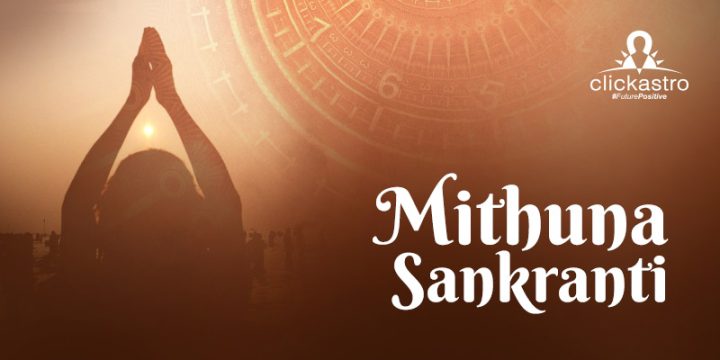Contents[hide]
Introduction
Mithuna Sankranti, also referred to as “Mithun Sankranti” or “Punya Sankranti,” is a vibrant festival celebrated across India. Falling on June 15th, 2024, this auspicious occasion marks the transition of the sun into the zodiac sign of Gemini. It symbolizes not only the astronomical phenomenon but also serves as a cultural and spiritual event. As the Sun moves into Gemini, it heralds the onset of a new season, signifying the shift from the sweltering heat of summer to the refreshing monsoon rains. Mithuna Sankranti is a time for communities to come together, express gratitude for nature’s blessings, and celebrate the abundance it provides in various forms. It is a celebration of life, fertility, and the cyclical rhythms of the natural world, fostering a deep connection between humanity and the environment.Significance
Mithuna Sankranti is a cherished festival in Indian culture. It is seen as a significant event as it reinforces our connection with nature. This auspicious occasion, falling on June 15th, 2024, marks the commencement of the sowing season and signals the anticipation of a bountiful harvest ahead. As the sun transitions into the zodiac sign of Gemini, it symbolizes not only the celestial phenomenon but also the cyclical rhythms of life and agriculture. For farmers, Mithuna Sankranti holds immense importance as it heralds the arrival of the monsoon rains. These rains are crucial for rejuvenating the parched lands, nourishing the soil, and facilitating the growth of crops. It is a time of hope and anticipation as farmers eagerly await the life-giving showers that promise agricultural prosperity in the coming months. Devotees pay homage to Lord Indra, the deity associated with rain and fertility, seeking his blessings for abundant harvests and agricultural abundance. Mithuna Sankranti is more than just the start of the agricultural season; it is a celebration of nature’s bounty and the interconnectedness of all living beings with the environment. It serves as a reminder of humanity’s dependence on the natural world for sustenance and livelihood. The festival fosters a deep appreciation for the beauty and resilience of nature, encouraging people to live in harmony with the Earth and its cycles.
As communities come together to celebrate Mithuna Sankranti, they express gratitude for the abundance provided by nature in various forms. It is a time of joy, camaraderie, and reflection, as individuals recognize their role as stewards of the environment. Through rituals, prayers, and cultural festivities, Mithuna Sankranti strengthens the bond between humanity and nature, emphasizing the importance of sustainable practices and environmental conservation for future generations to come.
Mithuna Sankranti is more than just the start of the agricultural season; it is a celebration of nature’s bounty and the interconnectedness of all living beings with the environment. It serves as a reminder of humanity’s dependence on the natural world for sustenance and livelihood. The festival fosters a deep appreciation for the beauty and resilience of nature, encouraging people to live in harmony with the Earth and its cycles.
As communities come together to celebrate Mithuna Sankranti, they express gratitude for the abundance provided by nature in various forms. It is a time of joy, camaraderie, and reflection, as individuals recognize their role as stewards of the environment. Through rituals, prayers, and cultural festivities, Mithuna Sankranti strengthens the bond between humanity and nature, emphasizing the importance of sustainable practices and environmental conservation for future generations to come.
Important Timings On Mithuna Sankranti 2024
- Sunrise – June 15, 2024 5:45 AM
- Sunset – June 15, 2024 7:09 PM
- Sankranti Moment – June 15, 2024 12:28 AM
- Punya Kaal Muhurta – June 15, 5:45 AM – June 15, 12:27 PM
- Maha Punya Kaal Muhurta – June 15, 5:45 AM – June 15, 7:59 AM
Festivities and Customs
The festival of Mithuna Sankranti is complete with a variety of customs and traditions that showcase the rich cultural diversity of India. These customs not only add color to the festivities but also carry deep spiritual and social significance, reinforcing the sense of community and interconnectedness among people.Bathing in Sacred Rivers:
One of the most revered customs associated with Mithuna Sankranti is the ritualistic bathing in sacred rivers. Devotees from all walks of life flock to rivers such as the Ganges, Yamuna, or Godavari to take a holy dip. It is believed that this act purifies the soul, washes away sins, and bestows blessings upon the devotees. The serene waters of these rivers become a conduit for spiritual renewal and rejuvenation, fostering a sense of inner peace and purification.Traditional Delicacies:
No celebration of Mithuna Sankranti is complete without the indulgence in delicious regional delicacies. From the sweet aroma of freshly prepared pitha to the savory flavors of dahi baigana and the decadent richness of chhena poda, these mouthwatering dishes tantalize the taste buds and evoke a sense of nostalgia. Each region of India boasts its unique culinary heritage, and Mithuna Sankranti provides an opportunity to savor the diverse flavors and textures that characterize Indian cuisine. Whether enjoyed with family and friends or shared with neighbors and strangers, these traditional delicacies embody the spirit of abundance and generosity that defines the festival.Decorative Rangolis:
Intricate rangoli designs are an integral part of Mithuna Sankranti celebrations, adorning the thresholds of homes and public spaces with vibrant patterns. These decorative artworks are created using colored powders, flower petals, or rice flour, reflecting the creativity and artistic expression of the people. Beyond their aesthetic appeal, rangolis hold symbolic significance, symbolizing prosperity, good fortune, and the welcoming of positive energy into the household. As families gather to create these intricate designs, they forge bonds of camaraderie and unity, strengthening the sense of community and belonging. In essence, the customs and traditions associated with Mithuna Sankranti encapsulate the essence of Indian culture, blending spirituality, gastronomy, and artistry into a mix of joy and celebration. As communities come together to partake in these rituals, they honor the timeless traditions passed down through generations and celebrate the vibrancy of India’s cultural heritage.
In essence, the customs and traditions associated with Mithuna Sankranti encapsulate the essence of Indian culture, blending spirituality, gastronomy, and artistry into a mix of joy and celebration. As communities come together to partake in these rituals, they honor the timeless traditions passed down through generations and celebrate the vibrancy of India’s cultural heritage.







